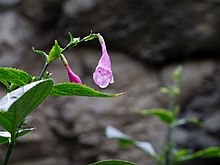en
names in breadcrumbs


Strobilanthes is a genus of about 350 species[2] of flowering plants in the family Acanthaceae, mostly native to tropical Asia and Madagascar, but with a few species extending north into temperate regions of Asia. Many species are cultivated for their two-lipped, hooded flowers in shades of blue, pink, white and purple. Most are frost-tender and require protection in frost-prone areas.[3]


Strobilanthes atropurpurea is a temperate species, native to eastern Siberia; it is cultivated for its purple flowers.
Strobilanthes dyeriana (Persian shield) is a tropical plant native to Myanmar. It is grown for its dark green foliage with bright, metallic-purple stripes radiating outward from the central leaf vein. In proper conditions, it will also produce pale purple flowers. Persian Shield grows best outdoors in USDA zones 9 and 10, although it can survive in other zones as a houseplant given sufficient temperature, soil moisture and humidity. It has gained the Royal Horticultural Society's Award of Garden Merit.[4]
Plants of the World Online currently includes:[1]
Strobilanthes species are food plants for the larvae of some Lepidoptera species including Endoclita malabaracus, which has been recorded on S. callosa.
 Strobilanthes cusia (Chinese rain bell)
Strobilanthes cusia (Chinese rain bell) Strobilanthes is a genus of about 350 species of flowering plants in the family Acanthaceae, mostly native to tropical Asia and Madagascar, but with a few species extending north into temperate regions of Asia. Many species are cultivated for their two-lipped, hooded flowers in shades of blue, pink, white and purple. Most are frost-tender and require protection in frost-prone areas.